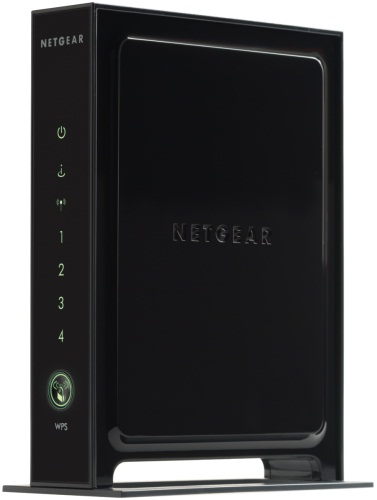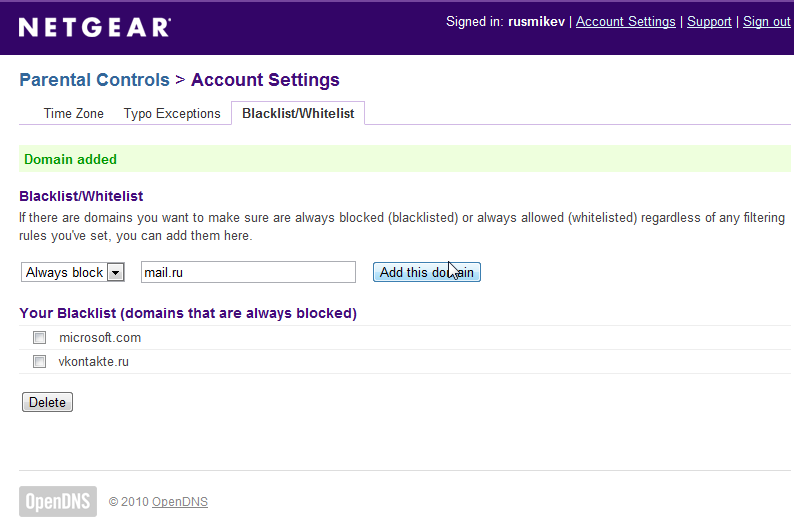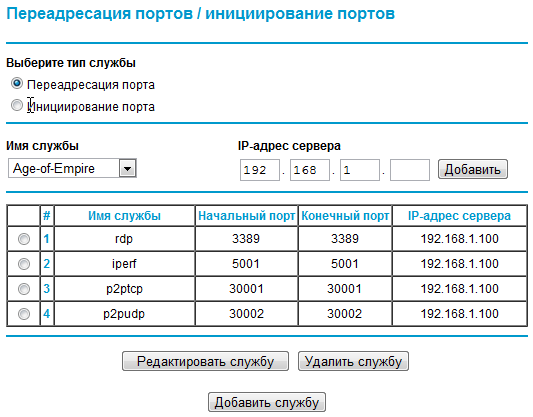Overview of the router NETGEAR WNR3500L
Hello, habrareyd and habragosti!
I saw a couple of reviews of NETGEAR routers on Habré lately and decided to make a contribution to this business. I’ve had a piece of hardware WNR3500L since April.
The key features of the router are the presence of gigabit ports, usb port, wi-fi n-standard and relatively low price (4500 recommended, less than 4000 - in inexpensive computer stores) for the proposed functionality. It is difficult for me to make a full review, due to the lack of the necessary iron for it at the right time and place, but I think I can write something interesting. Consciously included in the review a number of many obvious points that do not relate directly to the router, but, nevertheless, some habrat visitors can be new and interesting.

Matt grilles at the top and bottom (the manufacturer seems to offer only vertical installation of the router), matte plastic at the back (where the cables are connected) and good glossy dust and fingerprints on all other surfaces.
')

The rear panel contains: a connector for connecting the power supply, an on / off button, WAN and LAN ports, a usb port, a button for resetting to default settings.

As far as I know, this is the first NETGEAR model that supports PPPoE, L2TP and PPTP with simultaneous access to the local network and the external Internet (D-Link has this technology called DualAccess, Zyxel has Dual Link, ASUS / NETGEAR is not called anything - either works or not) and multicast-IPTV. The WNR3500 and WNDR3700 routers reviewed in recent reviews do not fully support dual access and iptv. For the WNDR3700, however, according to the manufacturer, this functionality is expected in subsequent firmware. For JWNR2000, L2TP support is available only in the beta version of the firmware.

The router supports the modern IEEE 802.11n wi-fi standard in its release edition, the frequency of 5 GHz is not supported. Encryption of WEP and WPA-PSK (TKIP) is not recommended - you can find instructions on how to hack networks protected in this way. WPA / WPA2 Enetrprise is not supported.



So, for example, my table looks like:

If you wish, you can specify one computer (or other device) as a DMZ server. In this case, all requests coming to the router and not specified in the rules will be forwarded to a specific IP. At this point, I’ll finish the description of the web interface.
100 megabits to the provider.
The provider's network uses the gray 10th IP to exchange information on the network and a VPN connection using L2TP (preferably) and PPTP (if there is no other choice) for Internet access.
VPN speed was measured using speedtest mini, located on the provider's hosting, correctness was controlled using i-speeder and bitmeter.
The speed in the local network of the provider was measured using i-speeder and bitmeter, the load was created by the dc ++ client.
The wi-fi speed was measured in close proximity to the router (distance less than a meter).
The measurements were repeated many times. You can ignore the outgoing speed here - the provider's VPN connection does not give out more than 35 megabits, speedtest shows numbers that are far from reality.
One of the key features - support for third-party firmware - has not yet been tested. If everything works out and the firmware will work fine with my provider, there will be another review.
Check the speed of file transfer between computers, see the performance limit on a gigabit connection and track the dependence of speed over wi-fi on the distance and obstacles I have so far had no opportunity to.
PS By virtue of their professional activities, it is increasingly necessary to write various texts. The style is slightly different there (the target audience is subscribers and Internet service provider employees), but I will be very grateful for comments regarding the style of the written text, design.
I saw a couple of reviews of NETGEAR routers on Habré lately and decided to make a contribution to this business. I’ve had a piece of hardware WNR3500L since April.
The key features of the router are the presence of gigabit ports, usb port, wi-fi n-standard and relatively low price (4500 recommended, less than 4000 - in inexpensive computer stores) for the proposed functionality. It is difficult for me to make a full review, due to the lack of the necessary iron for it at the right time and place, but I think I can write something interesting. Consciously included in the review a number of many obvious points that do not relate directly to the router, but, nevertheless, some habrat visitors can be new and interesting.
Appearance.
The appearance of the router differs little from the WNR2000 or WNR3500 (the image from the off site was used, the gloss won me).
Matt grilles at the top and bottom (the manufacturer seems to offer only vertical installation of the router), matte plastic at the back (where the cables are connected) and good glossy dust and fingerprints on all other surfaces.
')

The rear panel contains: a connector for connecting the power supply, an on / off button, WAN and LAN ports, a usb port, a button for resetting to default settings.
Specs
(taken from off site)physical characteristics
- Dimensions: 175 x 130 x 35 mm
- Weight: 0.33 kg
Functions
- Microprocessor BCM 4718 system-on-a-chip
- Gigabit Ethernet ports (4 LAN and one WAN) and USB
- Dual Firewall Protection
- Denial-of-service (DoS) protection
- Wi-Fi Protected Access ™ (WPA2-PSK, WPA-PSK) and WEP
- Wi-Fi Protected Setup ™ (WPS) - Button and PIN
- Push 'N' Connect using Wi-Fi Protected Setup (WPS) and Smart Wizard® standards
- IEEE 802.11n
- Five 10/100/1000 Ethernet ports (1 WAN and 4 LAN) with auto-sensing
Firmware.
The router is positioned by the manufacturer as an “open-source router”. In fact, in the basic delivery - this is all the same Netgear, with the standard for the routers of this company firmware and capabilities. Additional functionality can be added using various open-source firmwares, such as DD-WRT. On http://www.myopenrouter.com, you can find information about supported firmware versions (DD-WRT, OpenWRT, Tomato), about the nuances of installing on a router, features of customization. Unfortunately, the Russian-speaking community has not yet been properly formed, but I think that this will not be the case. Experiments with third-party firmware, I decided to postpone so far. The appearance of the web interface of the router is quite standard for Netgear. From the pleasant - the Russian-language interface, detailed help, which is displayed to the left of the corresponding controls. The speed of the firmware is pleasantly pleased - there is no need to wait for the router to restart when adding a new route or rule for port forwarding. From the unpleasant - I do not think that designers worked a lot on the appearance of the web interface. In a recent review of the router WNDR3700 Boomburum painted the possibilities of the firmware are described in sufficient detail. I will not dwell on what has already been described, I will indicate only those points that seemed to me significant.Supported Connection Types

As far as I know, this is the first NETGEAR model that supports PPPoE, L2TP and PPTP with simultaneous access to the local network and the external Internet (D-Link has this technology called DualAccess, Zyxel has Dual Link, ASUS / NETGEAR is not called anything - either works or not) and multicast-IPTV. The WNR3500 and WNDR3700 routers reviewed in recent reviews do not fully support dual access and iptv. For the WNDR3700, however, according to the manufacturer, this functionality is expected in subsequent firmware. For JWNR2000, L2TP support is available only in the beta version of the firmware.
Wi-Fi

The router supports the modern IEEE 802.11n wi-fi standard in its release edition, the frequency of 5 GHz is not supported. Encryption of WEP and WPA-PSK (TKIP) is not recommended - you can find instructions on how to hack networks protected in this way. WPA / WPA2 Enetrprise is not supported.

Content filtering - parental controls.
The NETGEAR Live Parental Controls Manager program allows you to customize content filters (see the WNDR3700 overview ), a custom interface allows you to enter time constraints. A small experiment showed that filter efficiency is far from 100% - 2-3 sites out of 10 with frivolous content (search technique - google.com and the most popular search query) it skips even at the highest level of filtering. Unwanted sites can be added by hand through the opendns account web management interface:
Port Forwarding
Working with a router (it doesn't matter if it is a separate specialized device or a system unit assembled for distributing the Internet) on the network is somewhat more complicated than directly from a computer. Not all requests coming to the ip of the router reach a computer or other connected device. It is good in some cases (viruses, network attacks, etc.), in some cases it is bad (for example, an ftp server running on your computer will not open from the outside without additional settings). The UPnP function enabled by default allows many applications to work through a router without additional settings. (for example, perfectly rustling bytes utorrent). For some applications (rdp - port 3389, http-server - port 80, dc ++), you must manually register the ports.
So, for example, my table looks like:

If you wish, you can specify one computer (or other device) as a DMZ server. In this case, all requests coming to the router and not specified in the rules will be forwarded to a specific IP. At this point, I’ll finish the description of the web interface.
Speed testing
Unfortunately, neither my home provider, nor my employer are in a hurry to connect me via a gigabit link, and I have no opportunity to fully test the speed on such a fast connection at home. Testing conditions:100 megabits to the provider.
The provider's network uses the gray 10th IP to exchange information on the network and a VPN connection using L2TP (preferably) and PPTP (if there is no other choice) for Internet access.
VPN speed was measured using speedtest mini, located on the provider's hosting, correctness was controlled using i-speeder and bitmeter.
The speed in the local network of the provider was measured using i-speeder and bitmeter, the load was created by the dc ++ client.
The wi-fi speed was measured in close proximity to the router (distance less than a meter).
The measurements were repeated many times. You can ignore the outgoing speed here - the provider's VPN connection does not give out more than 35 megabits, speedtest shows numbers that are far from reality.
Measured values:
- The speed of the local network - almost immediately went to the area of physical limitation - 100 megabits. Need to test on gigabit.
- The speed of the VPN connection with the default firmware rested at about 80 megabits. After installing the flashing firmware update, I did not notice the difference with the directly connected computer. All tests rest against approximately 90 megabits.

- With the D-Link DWA-140, TrendNET TEW-644-UB adapters, everything rested on the same 100 megabits. I do not think that the speed of a gigabit connection from the provider will be much higher, but there is progress in comparison with the g-standard.
- With the adapters D-Link DWA-125, NETGEAR WNA1100 managed to overclock only up to 70 megabits (values were reached and about 80, but this speed was not stable)
- With the NETGEAR WNA1100 adapter across two walls across and one almost parallel (at a very small angle) and 10 meters, the speed went out about 30-35 megabits, the signal level showed "very weak." The measurement was made once.
Multkast IPTV
Works. With a hd-stream of 20+ megabits, torrents and dc ++ simultaneously copes without complaints.Findings:
I liked the router. It is quick and easy to set up, it has all the necessary functions for me and for work in the provider's network, speed characteristics completely cover my current needs. Heated little, heat in Yekaterinburg (32-33) suffered calmly, did not complain. For several months (approximately since May) there were no complaints about the work of the router. Here is one remark - wi-fi, I used a very short time, only for testing.One of the key features - support for third-party firmware - has not yet been tested. If everything works out and the firmware will work fine with my provider, there will be another review.
Check the speed of file transfer between computers, see the performance limit on a gigabit connection and track the dependence of speed over wi-fi on the distance and obstacles I have so far had no opportunity to.
PS By virtue of their professional activities, it is increasingly necessary to write various texts. The style is slightly different there (the target audience is subscribers and Internet service provider employees), but I will be very grateful for comments regarding the style of the written text, design.
Source: https://habr.com/ru/post/101293/
All Articles